| Ej inloggad |
| Logga in |
| Mikrobiologi.net > Microbiology Highlights Arkiv |   |
NOVEMBER 2018:
Phenotypic AST in less than 30 minutes using digital LAMP quantification
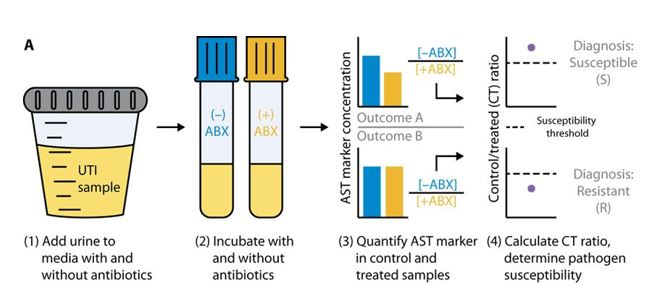 Typically, phenotypic antimicrobial susceptibility testing (AST) takes 1–2 days. With new techniques, the time can be shortened to 30 minutes, a time frame that is suitable for point-of-care testing. Digital loop-mediated isothermal amplification (LAMP) is a highly sensitive method for DNA amplification and quantification. Research demonstrate that digital LAMP can be applied to quantify bacterial 23S ribosomal DNA in urine samples after they are incubated for 15 minutes in the presence (+ABX) or absence (–ABX) of antibiotics. The ratio of bacterial DNA concentration (–ABX / +ABX) determines whether the bacterium is susceptible or resistant to the antibiotic. Link to full article in Science Translational Medicine
Typically, phenotypic antimicrobial susceptibility testing (AST) takes 1–2 days. With new techniques, the time can be shortened to 30 minutes, a time frame that is suitable for point-of-care testing. Digital loop-mediated isothermal amplification (LAMP) is a highly sensitive method for DNA amplification and quantification. Research demonstrate that digital LAMP can be applied to quantify bacterial 23S ribosomal DNA in urine samples after they are incubated for 15 minutes in the presence (+ABX) or absence (–ABX) of antibiotics. The ratio of bacterial DNA concentration (–ABX / +ABX) determines whether the bacterium is susceptible or resistant to the antibiotic. Link to full article in Science Translational Medicine
Contribution: Tianyan Song, M.D., Ph.D. Clinical Microbiology, Laboratory Medicine, University Hospital of Umeå. Published November 22, 2018.
OCTOBER 2018:
A parasitic disease on the increase in Sweden – Leishmaniasis 1993–2016
In the first nationwide study of the imported disease leishmaniasis, we linked data from national health care registers with information in databases of diagnostic laboratories, and calculated the annual incidence of Leishmaniasis in Sweden ranging from 0.02 to 0.36 per 100 000 person-years during the years 1993-2016. We also described demographic data, country of infection, infecting Leishmania-species, geographical distribution of cases, as well as results of diagnostic tests.
There was a rapid rise in the number of cases from 2013 through 2016 and 46% of these cases were children under 18 years. Most common were patients with cutaneous leishmaniasis from Syria, infected with Leishmania tropica.
Apart from migrants from endemic areas, Swedish residents travelling to endemic regions are at risk. One tenth of the Swedish population were born in Leishmania-endemic countries. In one year, 6.8 million trips were made to these same countries by Swedish residents, putting them at risk for cutaneous, visceral or mucocutaneous leishmaniasis, or latent infection which may manifest as clinical disease later in life.
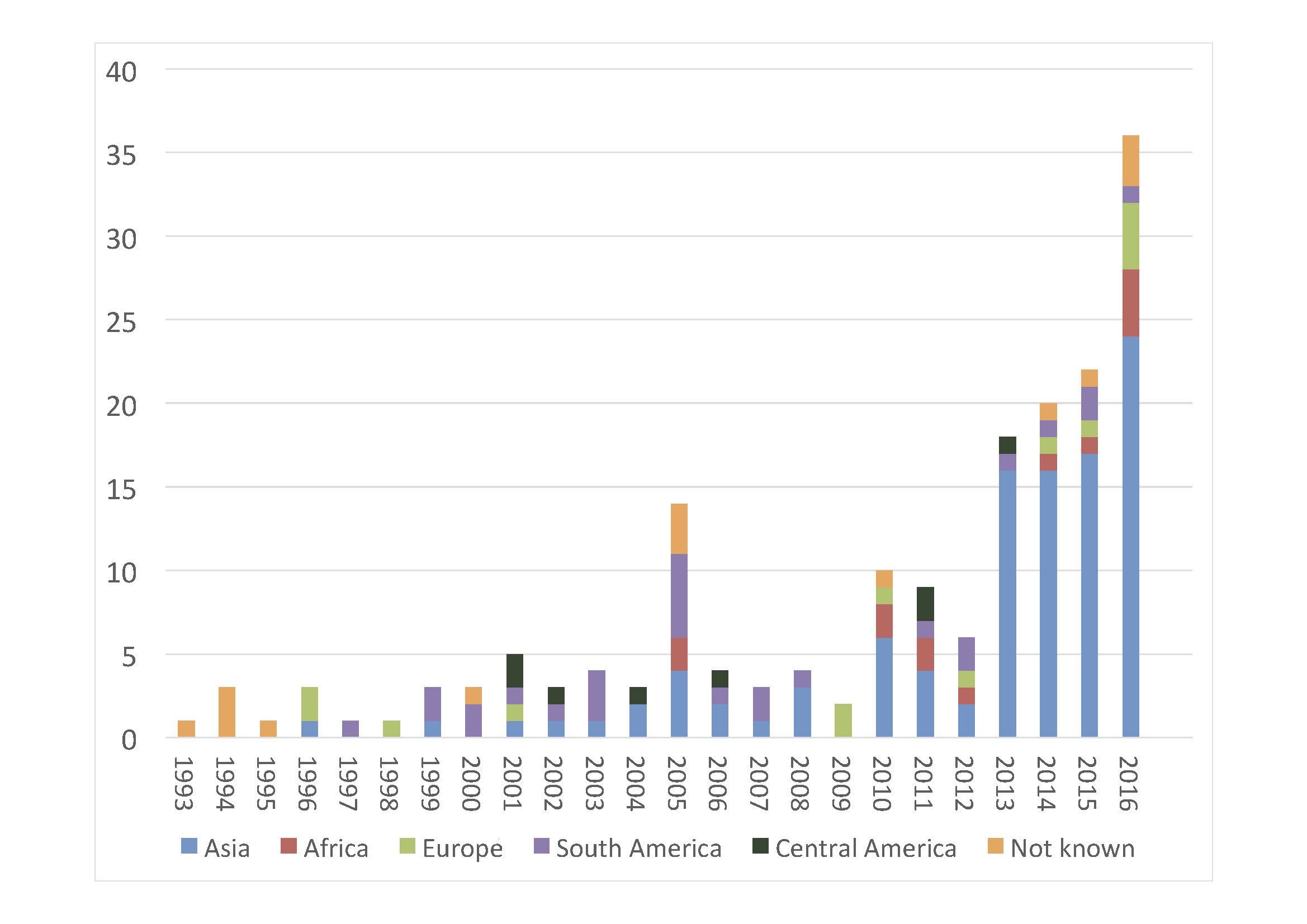 Imported Leishmaniasis in Sweden, confirmed cases 1993-2016 and region of infection. The rapid rise of cases had not yet peaked in 2016. Link to original paper in Epidemiology and Infection
Imported Leishmaniasis in Sweden, confirmed cases 1993-2016 and region of infection. The rapid rise of cases had not yet peaked in 2016. Link to original paper in Epidemiology and Infection
Contribution: Sara Karlsson Söbirk, Läkare /doktorand, Klinisk Mikrobiologi, Labmedicin Skåne, Avdelningen för Infektionsmedicin, IKVL, Medicinska Fakulteten, Lunds Universitet, sara.karlsson_sobirk@med.lu.se. Published October 22, 2018.
SEPTEMBER 2018:
Increase in transmitted NNRTI resistance in migrants from sub-Sahara diagnosed with HIV-1 in Sweden
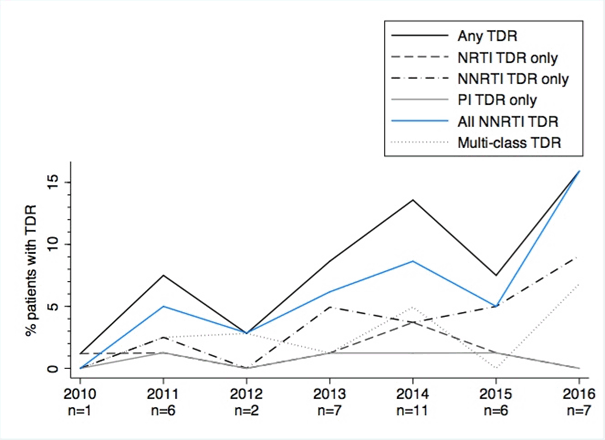
Transmitted drug resistance (TDR) 2010-2016 in patients infected in sub-Saharan Africa
To study transmitted drug resistance in individuals with HIV-1 diagnosed in Sweden, we analyzed pol sequences from 1,713 naïve patients diagnosed with HIV-1 in Sweden 2010-2016. Analysis revealed a steep increase in NNRTI resistance from 0% to 16% in individuals with origin in sub-Saharan Africa. This corresponds well to studies from sub-Sahara, where WHO now recommends to shift from efavirenz to dolutegravir backbone in populations heavily affected by transmitted drug resistance.
To monitor pre-treatment drug resistance in HIV-1 in Sweden is one objective of the ongoing prospective TIME-study, that includes patients from Karolinska University Hospital, Venhälsan and Sahlgrenska University Hospital. https://journals.lww.com/aidsonline/
Contribution: Dr Emmi Andersson, MD, PhD-student. Karolinska University Laboratory/Karolinska Institute. Published September 15, 2018
AUGUST 2018
Frequency of instrument, environment, and laboratory technologist contamination during routine diagnostic testing of infectious specimens

Photo kindly provided by: www.hygiene-diagnostics.se
By using fluorescent powder or gel markers (Glo GermTM) on the exterior of sample tubes and containers laboratory contamination can be measured in a very obvious way after UV-illumination. Laboratory handling of different instrument platforms for molecular biology and POCT, as well as different assay setups and sample types can be tested in the same way and then compared. Both contamination in the lab environment and on the lab technician can be measured by this simple method, as well as visualizing the spread of bacteria on hands and surfaces after hygienic procedures.
Contribution: Helena Enroth, PhD, Molecular Biologist at Unilabs and Adjunct Professor at the Department of Biosciences, University of Skövde. Published August 31, 2018.
JULY 2018
The response to cancer immunotherapy is dependent on the gut microbiota
The programmed cell death protein 1 ligand (PDL1) expressed by cancer cells supresses anti-tumour activity of cytotoxic T-cells by interaction with the PD1 receptor on those cells, which may be reversed by anti-PD1 immunotherapy. Recent studies have shown that a low diversity in the gut microbiota with high levels of the Bacteroidales order as well as exposure to broad spectrum antibiotics is associated to a poor response to anti-PD1 therapy. Additionally, three studies published in Science showed that faecal microbiota transplantation to germ-free mice from responders showed maintained efficacy and anti-tumour immune responses following anti-PD1 therapy compared to mice receiving faeces from non-responders. http://science.sciencemag.org/content/359/6371/32
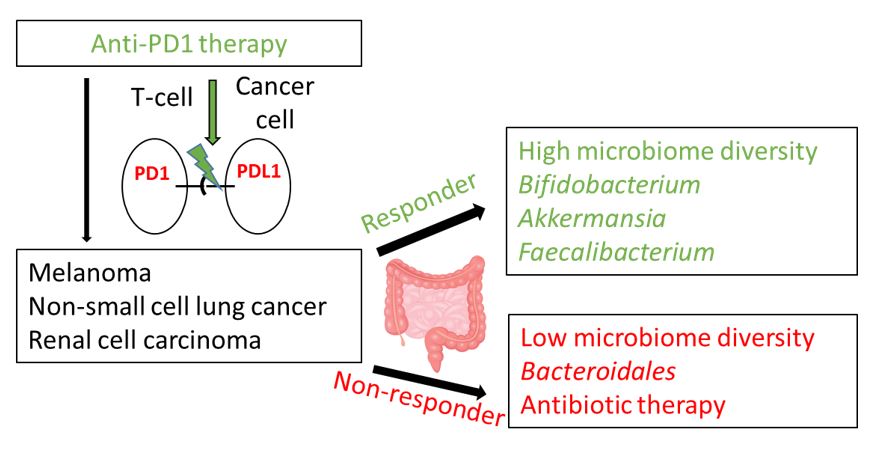
Contribution: Thomas Schön, Senior consultant in Clinical Microbiology and Infectious Diseases, Kalmar County Hospital. Associated professor at Department of Medical Microbiology, Linköping University. Published July 18, 2018.
JUNE 2018
Electricity in the gut microbiota is potentially medically important
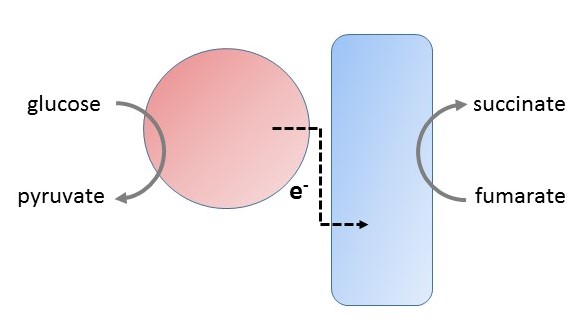
Enterococcus faecalis cells, present as commensals in the gut of mammals, are capable of extracellular electron transfer. That is, the cell can transfer electrons generated in glycolysis to an anode electrode generating a current, as recently demonstrated. This finding infers that in dense microbial communities, such as in biofilm and in the large intestine, metabolism in E. faecalis and similar Gram-positive lactic acid bacteria might be electrically connected to other microbes. For example, carbohydrate catabolism in the electron donating bacterial cell can be coupled to fumarate reduction in the electron accepting microbe. Such intercellular electron transfer confers syntrophic metabolism which can promote growth and other activities of bacteria in the microbiota of humans and animals.
Contribution: Lars Hederstedt, MD, Professor of microbiology, The Microbiology Group, Department of Biology, Lund University. Published June 18, 2018.
| Ⓒ Allt material på denna webbplats skyddas av upphovsrättslagen. Upphovs- och förfoganderätten tillhör Mikrobiologi.net och respektive upphovsman |
Contributions welcome!
Microbiology Highlights was started in June 2018. All members are welcome to submit contributions.
The format is as follows:
- A short title
- A text of maximum 100 words
- One picture (a photo, a sketch or a table)
- A subtitle "Contribution", presenting the author, including title, occupation and workplace or organisation.
- References and co-authors shoulde not be included
- It is allowed to attach a link or PDF file with additional information / full article.
- English is preferable but contributions in Swedish are also accepted.
Looking forward to receiving your contribution!
Please submit to
Ingvar Eliasson,
Mikrobiologi.net